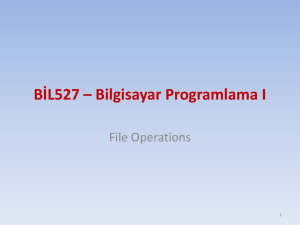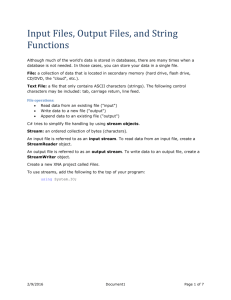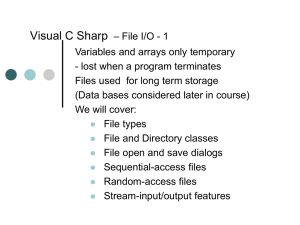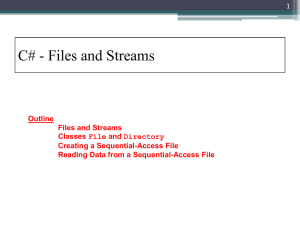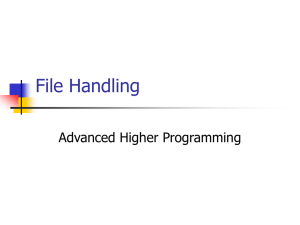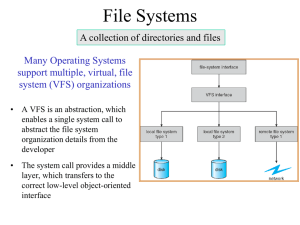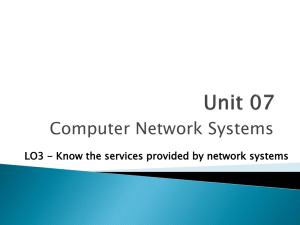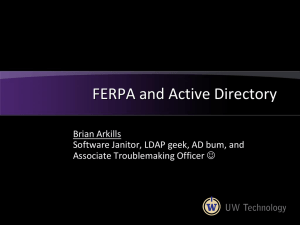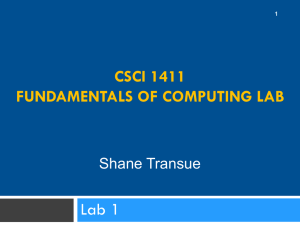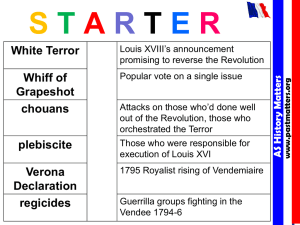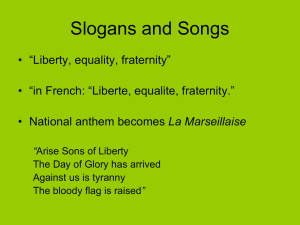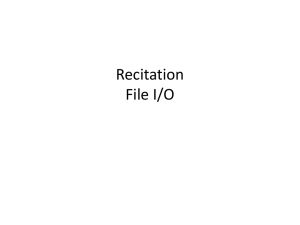Chapter 12
advertisement
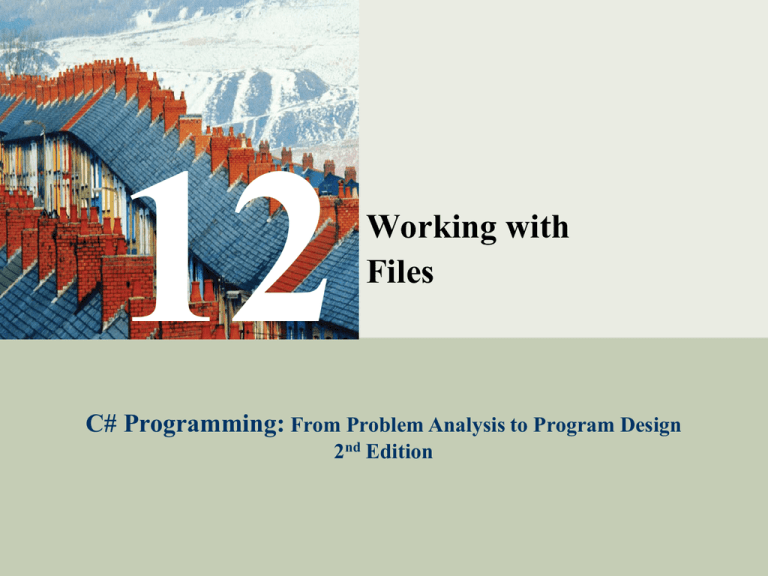
12
Working with
Files
C# Programming: From Problem Analysis to Program Design
2nd Edition
C# Programming: From Problem Analysis to Program Design
1
Chapter Objectives
• Learn about the System.IO namespace
• Explore the File and Directory classes
• Contrast the FileInfo and DirectoryInfo classes to
the File and Directory classes
• Discover how stream classes are used
• Read data from text files
C# Programming: From Problem Analysis to Program Design
2
Chapter Objectives (continued)
• Write data to text files
• Explore appending data to text files
• Use exception-handling techniques to process text
files
• Read from and write to binary files
C# Programming: From Problem Analysis to Program Design
3
System.IO Namespace
• Provides basic file and directory support classes
• Contains types that enable you to read and write
files and data streams
• Many of the types or classes defined as part of the
System.IO namespace are designed around
streams
C# Programming: From Problem Analysis to Program Design
4
System.IO Namespace (continued)
C# Programming: From Problem Analysis to Program Design
5
System.IO Namespace (continued)
Many are
exception
classes that
can be
thrown
while
accessing
information
using
streams,
files and
directories
C# Programming: From Problem Analysis to Program Design
6
System.IO Namespace (continued)
Figure 12-1 .NET file class hierarchy
C# Programming: From Problem Analysis to Program Design
7
File and Directory Classes
• Utility classes allow you to manipulate files and
directory structures
– Aid in copying, moving, renaming, creating,
opening, deleting, and appending files
• Expose only static members
– Objects are not instantiated from these classes
– To invoke the method, the method name is
preceded by the class name (as opposed to an
object’s name)
File.Copy(“sourceFile”, “targetFile”);
C# Programming: From Problem Analysis to Program Design
8
File Class
C# Programming: From Problem Analysis to Program Design
9
File Class (continued)
• Visual Studio intelliSense feature provides
information
Figure 12-2 IntelliSense display
C# Programming: From Problem Analysis to Program Design
10
File Class (continued)
• One static method of the File class is Exists( )
Example 12-1
/* DirectoryStructure.cs illustrates using File and Directory utilities. */
using System;
using System.IO;
class DirectoryStructure
{
public static void Main( )
{
string fileName = "BirdOfParadise.jpg";
if (File.Exists(fileName))
{
C# Programming: From Problem Analysis to Program Design
11
File Class (continued)
• GetAttritubes( ) returns a FileAttributes
enumeration
• Enumeration is a special form of value type that
supplies alternate names for the values of an
underlying primitive type
– Enumeration type has a name, an underlying type,
and a set of fields
C# Programming: From Problem Analysis to Program Design
12
File Class (continued)
Console.WriteLine( "FileName: {0}", fileName );
Console.WriteLine( "Attributes: {0}", File.GetAttributes(fileName) );
Console.WriteLine( "Created: {0}", File.GetCreationTime( fileName ) );
Console.WriteLine( "Last Accessed: {0}",File.GetLastAccessTime
( fileName ) );
GetAttributes( )
returns
enumeration
Figure 12-3 Output from the DirectoryStructure application
C# Programming: From Problem Analysis to Program Design
13
Directory Class
• Static methods for creating and moving through
directories and subdirectories
C# Programming: From Problem Analysis to Program Design
14
Directory Class (continued)
C# Programming: From Problem Analysis to Program Design
15
DirectoryInfo and FileInfo Classes
• Add additional functionality beyond File and
Directory classes
– Difference – Both have instance methods instead of
static members
– Both have public properties and public constructors
– Neither can be inherited
C# Programming: From Problem Analysis to Program Design
16
C# Programming: From Problem Analysis to Program Design
17
DirectoryInfo
• Adds two other key properties, Parent and Root
– Parent gets the parent directory of a specified
subdirectory
– Root gets the root portion of a path
– Be careful with paths; they must be well-formed or
an exception is raised
DirectoryInfo dir = new DirectoryInfo(".");
Console.WriteLine("Current Directory: \n{0}\n",
Directory.GetCurrentDirectory( ));
C# Programming: From Problem Analysis to Program Design
18
File Streams
• Several abstract classes for dealing with files
• Stream, TextWriter, and TextReader
• Stream classes provide generic methods for
dealing with input/output
– IO.Stream class and its subclasses – byte-level data
– IO.TextWriter and IO.TextReader – data in a text
(readable) format
• StreamReader and StreamWriter derived classes of
IO.TextWriter and IO.TextReader
C# Programming: From Problem Analysis to Program Design
19
File Streams (continued)
• StreamWriter class for write data to text file
– Includes implementations for Write( ) and WriteLine( )
• StreamReader class to read or and from text files
– Includes implementations of Read( ) and ReadLine( )
• System.IO namespace
– Using System.IO;
C# Programming: From Problem Analysis to Program Design
20
File Streams (continued)
StreamWriter outputFile = new
StreamWriter("someOutputFileName");
StreamReader inputFile = new
StreamReader("someInputFileName");
• outputFile and inputFile represent the file stream
objects
• Actual file names are “someOutputFileName” and
“someInputFileName” – inside double quotes
– Place file extensions such as .dat, .dta, or .txt onto the
end of actual filename when it is created
C# Programming: From Problem Analysis to Program Design
21
File Streams (continued)
• Use Write( ) or WriteLine( ) with the instantiated
stream object
outputFile.WriteLine("This is the first line in a text file");
• Use Read( ) or ReadLine( ) with the instantiated
stream object
string inValue = inputFile.ReadLine( );
C# Programming: From Problem Analysis to Program Design
22
File Streams (continued)
C# Programming: From Problem Analysis to Program Design
23
File Streams (continued)
C# Programming: From Problem Analysis to Program Design
24
Writing Text Files
• Enclosed attempts to access text files inside
try…catch blocks
• Constructor for StreamWriter class is overloaded
– To Append data onto the end of the file, use the
constructor with Boolean variable
fileOut = new StreamWriter(“../../info.txt”, true);
• true indicates to append
• Values are placed in the file in a sequential fashion
C# Programming: From Problem Analysis to Program Design
25
Writing Text Files – SayingGUI
Application
• Three event-handler methods included
– Form-load event handler, an object of the StreamWriter
class is instantiated
• Included in a try…catch clause
– Button click event-handler method retrieves the string
from the text box and writes the text to the file
• Also enclosed in a try…catch clause
– Form closing event closes the file and releases
resources associated with file
• Also enclosed in a try…catch clause
C# Programming: From Problem Analysis to Program Design
26
Writing Text Files (continued)
using System.IO;
// Added for file access
private StreamWriter fil; //Declares a file stream object
: // more statements needed
try
{
fil = new StreamWriter(“saying.txt”);
}
: // more statements needed
try
{
fil.WriteLine(this.txtBxSaying.Text);
this.txtBxSaying.Text =“”;
}
C# Programming: From Problem Analysis to Program Design
Instantiate
StreamWriter
object
Retrieve value
from text box;
write it to the
file
27
Writing Text Files – SayingGUI
Application (continued)
If a path is
not
specified
for the file
name, the
bin\debug
subdirectory
for the
current
project is
used
Figure 12-7 DirectoryNotFoundException thrown
C# Programming: From Problem Analysis to Program Design
28
Reading Text Files
• StreamReader class enables lines of text to be read
from a file
• Constructor for StreamReader is overloaded
– Can specify different encoding schema or an initial
buffer size
• Can use members of parent or ancestor classes or
static members of the File class
– To avoid programming catch for FileNotFoundException
or DirectoryNotFoundException, call
File.Exists(filename)
C# Programming: From Problem Analysis to Program Design
29
Reading Text Files (continued)
using System.IO;
// Added for file access
private StreamReader inFile; // Declares a file stream object
:
// more statements needed
if (File.Exists(“name.txt”))
{
try
{
inFile = new StreamReader(“name.txt”);
while ((inValue = inFile.ReadLine()) != null)
{
this.lstBoxNames.Items.Add(inValue);
}
C# Programming: From Problem Analysis to Program Design
Retrieve values
from file; place
them in a
ListBox
30
Reading Text Files –
FileAccessApp Application
• Read from text files in sequential fashion
Figure 12-8 Content of name.txt file
C# Programming: From Problem Analysis to Program Design
Figure 12-9 Output
31
Adding a Using Statement
• Define a scope for an object with the using
keyword
– CLR automatically disposes of, or releases, the resource
when the object goes out of scope
– Useful when working with files or databases
• When writing data to a file, the data is not stored in the
file properly until the file is closed
– Fail to close the file – you will find an empty file
– With using block, not necessary for you to call the Close( )
method – automatically called by the CLR
C# Programming: From Problem Analysis to Program Design
32
Adding a Using Statement
(continued)
try
{
• StreamReader object is
defined and
instantiated inside the
using (StreamReader inFile = new
using block
StreamReader("name.txt"))
• By instantiating the
{
while ((inValue = inFile.ReadLine()) != null) inFile object here, the
object exists only in
{
this block
this.lstBoxNames.Items.Add(inValue);
}
• You are guaranteed
}
the file is closed when
you exit the block
C# Programming: From Problem Analysis to Program Design
33
BinaryReader and BinaryWriter
Classes
• Files created are readable by the computer
– You cannot open and read binary file using Notepad
C# Programming: From Problem Analysis to Program Design
34
C# Programming: From Problem Analysis to Program Design
35
Other Stream Classes
• NetworkStream class provides methods for
sending and receiving data over stream sockets
– Methods similar to the other stream classes, including
Read and Write methods
• MemoryStream class used to create streams that
have memory as a backing store instead of a disk
or a network connection
– Reduce the need for temporary buffers and files in an
application
C# Programming: From Problem Analysis to Program Design
36
FileDialog Class
• Enables browsing to a specific location to store or
retrieve files
– Displays Open file dialog box to allow user to traverse
to the directory where the file is located and select file
– Displays a Save As dialog box to allow user to type or
select filename at runtime
• OpenFileDialog and CloseFileDialog classes
– Classes are derived from the FileDialog class
– FileDialog is an abstract class
C# Programming: From Problem Analysis to Program Design
37
FileDialog Class (continued)
• FileName property is used by OpenFileDialog and
CloseFileDialog
– Set or get the name of the file from the dialog box
• Drag the OpenFileDialog and/or the
CloseFileDialog control from the toolbox onto
your form
– Placed in the component tray
C# Programming: From Problem Analysis to Program Design
38
FileDialog Class (continued)
Figure 12-13 Placing OpenFileDialog and SaveFileDialog controls
C# Programming: From Problem Analysis to Program Design
39
FileDialog Class (continued)
• ShowDialog( ) method used to cause the dialog
boxes to appear
openFileDialog1.ShowDialog( );
saveFileDialog1.ShowDialog( );
or
• To retrieve the filename from the textbox in the
dialog box, use the FileName property
• Retrieved value can be used as the argument for the
stream object instantiation
SreamReader inFile = new
StreamReader(openFileDialog1.FileName);
C# Programming: From Problem Analysis to Program Design
40
FileDialog Class (continued)
Figure 12-14 ShowDialog( ) method executed
C# Programming: From Problem Analysis to Program Design
41
ICW WaterDepth File App Example
• Graphical user interface solution was designed for
application in Chapter 11
– Review the problem specification in Figure 11-21
• Modified to allow the results to be captured and
stored for future use
– Data stored in a text file
Figure 12-15 Data file prototype
C# Programming: From Problem Analysis to Program Design
42
Figure 12-16 Values stored in a text file
C# Programming: From Problem Analysis to Program Design
43
Chapter Summary
• System.IO namespace
• File and Directory classes
– Static members
– Copy, move, append to, and rename files
– Create, delete, and rename directories
• FileInfo and DirectoryInfo classes
– Added functionality to File and Directory classes
– Instantiate objects of these classes
C# Programming: From Problem Analysis to Program Design
44
Chapter Summary (continued)
• StreamReader
• StreamWriter
• BinaryReader and BinaryWriter classes
– Create and access binary (non-readable) files
• FileDialog
– OpenFileDialog
– CloseFileDialog
– ShowDialog used to display dialog box
C# Programming: From Problem Analysis to Program Design
45
